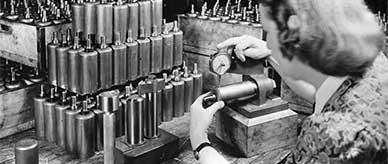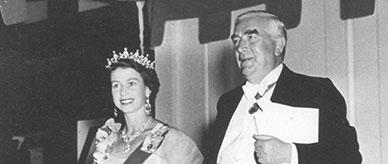
Transcript
Narrator: The Montebello bomb and all the equipment for this experiment were made in British workshops by British workmen.
Accurate to one ten-thousandth of an inch – that was the precision demanded and achieved – both for the bomb and for the instruments to measure its performance.
At Fort Halstead [atomic weapons research facility in Britain] they made two high-speed cameras, taking pictures at the rate of 100,000 in one second. With these cameras the scientists could reconstruct the pattern of the explosion in the first revealing fraction of a second.
In concept and design this camera was entirely British and design became reality in the hands of fine craftsmen.
At every stage, check and double-check.
Instruments, too, for testing the impact of the explosion, for measuring heat, blast and radiation, for gauging the instant shaft of gamma ray and the lingering poison of radioactivity – all these designed and produced at Halstead, Harwell and other atomic energy establishments.
This electronic equipment will carry the circuit to actuate the firing mechanism in the bomb itself.
Here, the designers’ demands reach the peak of precision – an accuracy of one-millionth of a second. Nothing was left to chance … how the bomb would perform when the testing time came. Many minds and many hands were turned to the making of this atomic weapon, but only half a dozen knew the whole secret of the bomb’s design. They knew they were making a weapon of awe-inspiring power, but they would never see the finished product, never even know, perhaps, the ultimate function of the parts they handled with such care.
[INDUSTRIAL SOUNDS]
Narrator: Inside headquarters the rest of the control party are waiting at their instruments. In the half-light of the control room the safety link is delivered to the controller. The final process of firing can now be set in train.
Man 1: Time bracket – open. Fox George this is Howell 1. How’s your message? Over.
Voice on radio: Hello Howell 1, this is Fox George. A Saturn completed. Over.
Man 1: Understand A Saturn completed. Out.
Controller: Right. You can put the safety key in now.
Narrator: Safety link in. Circuit complete.
Man 1: Can we have the all-ready signals, please? [PAUSE] Mr Abercrombie, please. Thank you. [PAUSE] Minus 8 and a half minutes.
[MUSIC]
Man 1: Minus 7 minutes.
[MUSIC]
Man 1: Minus 6 minutes.
[MUSIC]
Man 1: Minus 5 minutes.
[MUSIC]
Man 1: Minus 4 minutes.
[MUSIC]
Man 2: Take the bolts out.
Man 1: Minus 3 minutes.
[MUSIC]
Man 1: Minus 2 minutes.
[MUSIC]
Man 1: Minus 1 and a half minutes.
[MUSIC]
Man 1: Minus 55 seconds.
[MUSIC]
Man 1: 25.
[MUSIC]
Man 1: 20.
MUSIC]
Man 1: 10.
[MUSIC]
Man 1: 5-4-3-2-1. Now!
[EXPLOSION]
[SILENCE]
[MUSIC]
Narrator: That lethal cloud rising above Montebello marks the achievement in science and industry in the development of atomic power. [For] good or evil, for peace or war, for progress or destruction. The answer doesn't lie with Britain alone, but we may have a greater voice in this great decision if we have the strength to defend ourselves and to deter aggression.
That was the meaning of Montebello.
[END]
About this record
This clip, from a documentary made by Anvil Films for the British Ministry of Supply, is about Operation Hurricane – the first British atomic bomb test, conducted in the Montebello Islands 100 kilometres off the north-western coast of Western Australia in October 1952. The clip begins inside British workshops where monitoring instruments, explosion-measuring devices, documentation equipment and parts of the bomb are manufactured and tested. The final stages and countdown, including the bomb’s detonation and explosion, are recorded on the island in both colour and black and white.
Educational value
- Operation Hurricane was the first of three nuclear weapons testing operations carried out in Australia by the British Government in 1952 and 1956 with the support of the Australian Government. Concerned about communist expansion, particularly in parts of Asia, Prime Minister Robert Menzies felt that Australia needed to cultivate its ‘great and powerful friends’, such as Britain, and agreed to host Britain’s nuclear weapons tests on Australian territory in the interests of national security.
- Operation Hurricane occurred in the context of an escalation in the Cold War and anxieties about the use of nuclear weapons by communist countries such as the Soviet Union (which had exploded its first nuclear bomb in 1949). In 1947, with the United States unwilling to share nuclear technology, Britain embarked on its own nuclear weapons program and began searching for a testing site remote enough to guarantee security and minimise the risk to public health.
- The atomic explosion shown in this clip was produced by a 25-kiloton nuclear fission bomb, which was detonated in a lagoon 700 metres off Trimouille Island in the Montebello archipelago. It created a crater in the ocean floor more than 6 metres deep and more than 300 metres wide. The test was intended to provide information about how foodstuffs, shipping and defensive structures would be affected by nuclear explosions and subsequent radioactive fallout – hazardous airborne radioactive dust particles that fall to the ground.
- This nuclear testing operation in the Montebello Islands was conducted in great secrecy. In agreeing to host the British tests in 1951, there is no evidence to suggest that Prime Minister Menzies consulted with Cabinet. The decision was made public in February 1952. Public understanding at the time about the tests and debates on their human and environmental impact was limited. However, as opposition to nuclear weapons grew in the 1950s, the public reacted more strongly to successive British tests at Emu Field and Maralinga.
- In 1985 the Royal Commission into British Nuclear Tests in Australia found that the Montebello Islands were an unsafe and inappropriate location for the Hurricane tests and that the Australian Government was given insufficient information as to the possible effects of the radioactive fallout. Today, visitors to Montebello’s three ground zero sites are advised to spend no more than one hour per day in these areas and to avoid handling or removing objects, which may be radioactive.
- The film, released in 1953, places an emphasis on the precision, testing and advanced technology used in the manufacture, testing and documenting of the effects of a nuclear explosion. It is likely that the film was used as propaganda to inform the British public of the value of nuclear weapons research for both domestic and defence purposes and to reassure them that the technology was safe. The film also underlines Britain’s independence from the United States.
Acknowledgments
Learning resource text © Education Services Australia Limited and the National Archives of Australia 2010.
Related themes
Need help with your research?
Learn how to interpret primary sources, use our collection and more.


